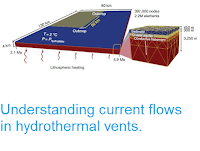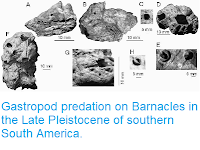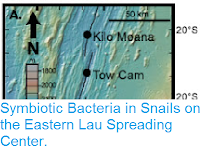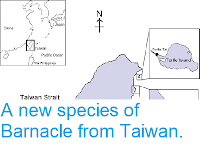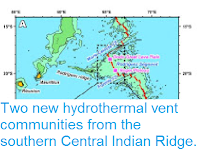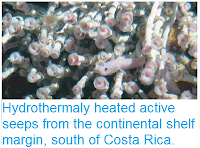Barnacles are Crustaceans, related to Shrimps, Crabs and Lobsters, but
having a remarkably different lifestyle, with a free-swimming larval
stage that then settles on rocks, or other substrates, and becomes an
immobile filter-feeder, protected by a mineralised shell. Some species
have become parasites on other Crustaceans, and have even more modified
body-plans, growing through the host's tissues like a fungus. The genus Neolepas comprises Goose Barnacles (Barnacles with stalks) found around hydrothermal vents in the Pacific and Southern Oceans.
In the paper published in the journal Royal Society Open Science on 1 April 2018, Hiromi Watanabe of the Department of Marine Biodiversity Research at the Japan Agency for Marine-Earth Science and Technology, Chong Chen of the Department of Subsurface Geobiological Research also at the Japan Agency for Marine-Earth Science and Technology, Daniel Marie of the Mauritius Oceanography Institute, Ken Takai also of the Department of Subsurface Geobiological Research at the Japan Agency for Marine-Earth Science and Technology, Katsunori Fujikura, again of the Department of Marine Biodiversity Research at the Japan Agency for Marine-Earth Science and Technology, and Benny Chan of the Biodiversity Research Center at Academia Sinica, describe a new species of Neolepas from hydrothermal vents in the Indian Ocean.
The new species is named Neolepas marisindica, where 'marisindica' means 'Indian sea', in reference to the area where it was found. It has an outer shell composed of eight calcified plates, 26 scales per whirl on its stalk and a hatchet shaped mandible. The species appears to be widely distributed in the Indian Ocean, having been found in the Kairei and Solitaire vent fields on the Central Indian Ridge, the Longqi Hydrothermal Field on the South West Indian Ridge, and an unnamed site on the South East Indian Ridge.
Two specimens of Neolepas marisindica from the Kairei Vent Field on the Central Indian Ridge. Watanabe et al. (2018).
See also...
Follow Sciency Thoughts on Facebook.


